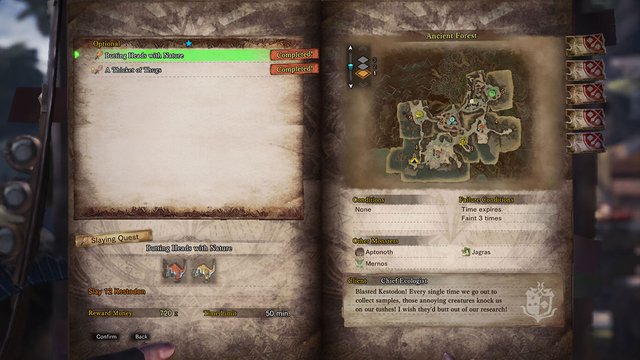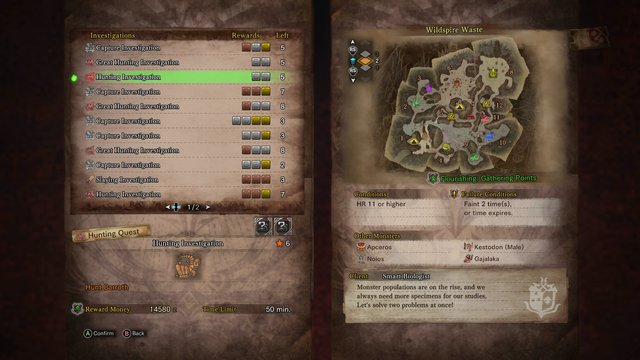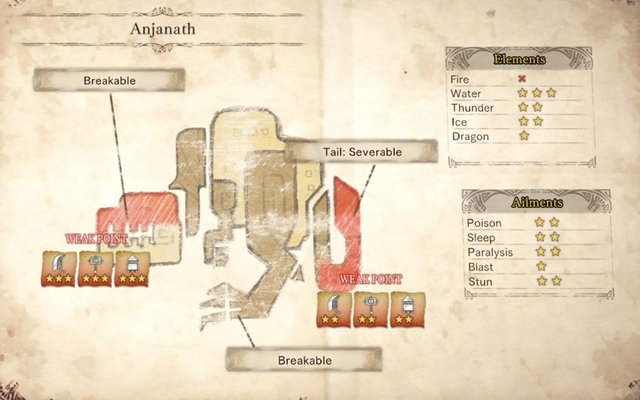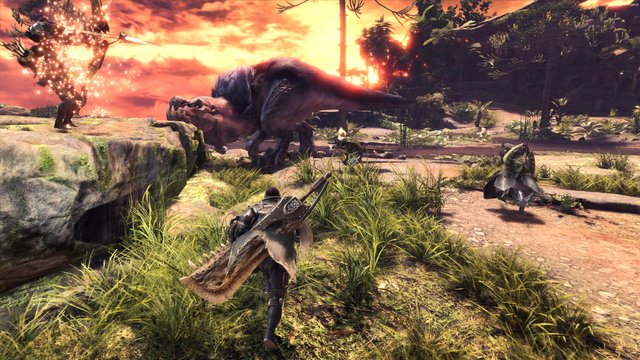Here's How to Hunt in Monster Hunter: World
Monster Hunter games are packed with gameplay, and there's a ton to do besides hunting - especially in World, with its extremely rich flora and fauna. But the bread-and-butter of these games is the hunt. Getting used to hunting in Monster Hunter takes a little time, especially because of the game's unique combat and refined hunting system.
To summarize hunting, you're sent after a monster into a map, tasked to comb it area by area until you come across the monster, and then your job is to deal enough damage to the monster to kill it/capture it, in order to fulfill your mission.
It sounds simple enough, but there's a lot to consider and a lot to learn if you want to get good enough to unlock the more difficult challenges and more interesting monsters the game has to offer. Before we get into the hunt itself, it's important to talk about progression.
In MH:W, there are two experiences. The first is Low Rank, a series of monsters and miscellaneous quests designed to get you acquainted to the game, its mechanics, and the act of tracking and hunting monsters with all the tools the game has to offer.

The second is High Rank. This is where the game proper begins, as you're pitted against tougher foes, many familiar monsters (with upgraded stats and a wider movepool), and a more complex list of gear choices and considerations. When High Rank begins, the game stops babying you, and it expects you to know what you're doing.

If you're new to Monster Hunter, Low Rank does a good job of getting you used to the game - but the game itself does not do the best job of explaining everything to you. This is good, because there is a lot to explain, and it would bog down the action if it pulled you away from combat every two minutes to introduce a new mechanic. But if you're stuck on a particularly tough monster, and aren't sure what you're doing wrong, it's time to take a step back and do some reading. Today, we'll go over the basics of hunting in Monster Hunter, and I'll make sure you're equipped with all the knowledge you need to make it through the game.
The Rules
First, the basics. Monsters in Monster Hunter all have a hidden health value and hidden defensive values for each of their body's segments. Every segment, or hitzone, has different defenses for every type of damage in the game (impact, shot, cutting). Some types of damage, like barrel bombs, charge blade phials or a gunlance's shell, ignore hitzone defenses entirely.

Monsters also have stamina. This stamina wears down naturally over the course of a fight, or can be worn down faster with exhaust damage, which is dealt by blunt/impact weaponry (hammers, charge blades, SnS shield bashes). When a monster's stamina has dropped considerably, they get sluggish and struggle to attack.
You, on the other hand, also have health and stamina, clearly visible at the top-left of the screen. Stamina is consumed by running and blocking. Your stamina meter naturally replenishes if you stop running or blocking, although certain circumstances can slow its recovery, or increase the rate at which it is consumed. After some time, your stamina bar will decrease. This is meant to represent your hunter slowly getting hungry over the course of a hunt. Eating cooked meat or a ration will replenish your stamina capacity.
Health is reduced through monster attacks, barrel bombs, and the consumption of bitterbugs. The health bar is at a minimum a total value of 100, increased to a maximum of 150 through eating a meal before a hunt. The bar itself does not decrease, unlike the stamina bar. You can replenish your health with potions, med kits, herbs, and vigorwasps.
When your health drops down to 0, your hunter will faint, costing you one cart and a portion of your reward for the quest. Fainting thrice fails the quest, ending it and forcing you to restart. In short, keep your hunter healthy, or else you'll risk failing the quest. Carts are shared - so even if you've only fainted twice, if anyone else faints it counts towards the total cart count of the quest.
Your palico also has a health value, but if they take too much damage, they simply take a break from the hunt for a while, rather than contributing to the quest failing.
Every quest starts off with a total reward, awarded to every participating hunter and divided according to the number of participating hunters (a maximum of 4) and the number of carts used (a maximum of 3). One cart costs you a third of the total reward, meaning the quest technically fails when the reward hits zero. Doing quests alone nets you the most money, but if you aren't skilled enough, it will also cost you the most carts.
Monster Behavior and Why It Matters
In Monster Hunter, monsters have more than just a series of attacks and movement. They have behavior. They stagger, grow tired, take a nap, hunt other monsters, protect their offspring, get enraged, and react according to a wide variety of environmental factors and circumstances. Monsters taunt and roar, and they feel alive in every sense.

At first, this can be incredibly overwhelming. Your first time against a monster will be against an unknown foe, whose movements are organic yet seemingly unpredictable, whose speed might almost make it feel like any effort to attack will ultimately be punished with a counterattack.
But with time, they become predictable, and their movements and behaviors become a part of you. Our brains are made to see patterns in things, and we survived as long as we have because we learn, very quickly. We instinctively avoid mistakes once they've been made, and we develop and shed habits as they're needed. It takes longer for some than others, and motivation is a big factor of how long it takes, but our ability to learn is nearly unprecedented in the animal kingdom.
As a new hunter, your ability to read monsters relies simply on one thing: how many you've hunted. And even after the first hundred hours, there will still be monsters you aren't comfortable with, nuances you haven't picked up on, movements and behaviors that happen without you realizing what cue the monster uses to announce them.
Learning to hunt in Monster Hunter means understanding the concept of cues and tells - every action a monster does is foretold by a repeated behavior, no matter how subtle. A Teostra that stops and stares for just a while too long after releasing a blast cloud is going to click and set it off, before stretching its neck for a window of opportunity. Molten and Brute Tigrex inhale just half a second longer before roaring twice in a row. Silver Rathalos will dive in with its talons, then back up, inhale, and throw a fireball.
But beyond the simple cues, all monsters share a few different behaviors that help you understand how the hunt is going, how far along you are, and how much further you've got to go.
Rage
Every monster gets enraged, and in some cases it's more obvious than in others. Most monsters become more energetic, and their movements are coupled with furious attacks that typically deal more damage. Some monsters have tell-tale signs, such as wreathe of flame around Rathalos' mouth, enraged slime on a Brachydios, or glowing veins on a Molten Tigrex.
Enraged monsters not only deal more damage, but take a little more as well. They're aggressive, but it's an opportunity for skilled hunters to finish the fight faster. In addition, a certain armor skill gives hunters a massive boost to overall power during rage mode (Challenger in previous games, Agitator in World).
Exhaustion
Monsters become naturally exhausted over the course of the hunt, and as their stamina depletes faster and faster, they become sluggish and trip often. Some monsters simply drool and stop to "catch their breath" every now and again, while others downright fail to execute certain attacks: a tired Rathalos will try to breathe a fireball and will instead only cough up a few sparks of flame, while a Tigrex will attempt to charge you across the map, only to trip and fall in exhaustion afterwards. This gives you a sense that the hunt is slowly coming to an end, as the monster is having trouble.
Another telltale sign of a tired monster near death is the continuous switching between an exhausted state and an enraged state. As their hidden health value drops into the lower percentages, monsters will constantly get angry and tired.
Certain weapons deal impact damage to make monsters tired faster, speeding up the rate at which they grow sluggish and making them easier to fight.
Limping
When a monster starts limping away, they're near the end of their life. This is the only time at which you can successfully capture a monster (more on that later), and it also means the hunt is almost over. Often enough, a limping monster can be easily finished off with a little patience and preparation, which leads us to the next tip.
Sleep
Sleep is a state a monster naturally goes into when they've taken massive amounts of damage and need to "sleep it off". A sleeping monster will replenish their stamina, and regenerate minute amounts of health, effectively providing a little bit of a challenge in the monster's final moments, but nothing substantial. They also do not regenerate a lot of their health.
Sleeping monsters won't react to sound - so you can freely kill small monsters around them - but they do wake up when hit. Any damage dealt to the sleeping monster is doubled if it hits first, but only if it hits first. This counts even if multiple sources of damage go off at once - only the "first" is registered as a double hit. To capitalize this, place large barrel bombs around the monster (it does not matter where) and wake it up with powerful single hit, such as a greatsword's true charged slash.
Sleep is also a status applied by some weapons. While difficult to coordinate properly in multiplayer, with a skilled group of hunters you can easily put a monster to sleep several times and utilize a number of bombs and strong hits to dispatch it efficiently.
Turf Wars
Monster Hunter: World introduced a new mechanic regarding monster interaction - the ability for monsters to engage in a unique battle with one another. In the past, two monsters in the same area would both focus their attention on the hunter. Their attacks would deal damage to the other monster, but they would not actively fight against each other.

In Monster Hunter: World, there is a unique interaction between every monster, a particular display of strength or prowess. It seems to follow the rules of the food chain - a Great Jagras won't have the strength to fight an Anjanath, and Anjanath can't hope to kill a Rathalos without help. So they pick each other up, fling each other around, stomp and chomp and slash their way through the area until one monster flees, or dies.
Do not get into the middle of a turf war. It is not a good opportunity for you to look for cheap shots - while ranged hunters might have a chance to dish out a little extra damage between bouts, it's not a good idea for a single melee hunter to draw the ire of two enraged monsters at once, without a solid escape plan. Instead, let the monsters do the hunting for you, and pick off the winner.
How Not to Get Hit
Evading in Monster Hunter is as simple as pulling your analog stick in a certain direction, and tapping the evade button (cross on the PS4). However, unlike Dark Souls, the invincibility frames on the dodge roll are miniscule. You're invincible as long as you're in the air, which isn't very long - a few frames at most. This isn't enough to roll through attacks, but it is enough to roll through the stagger from most roars in the game, and to roll through tremor/some attacks in previous games. However, dodge rolling through roars/tremors and certain attacks without evasion skills (which boost your invincibility frames) is very, very tough. Evasion skills and the inclusion of a late-game item vastly improve your invincibility frames, but they are not necessary for skilled or efficient play.
So for most people, the advice is to use the evade roll for spacing/dodging away from attacks, rather than through. When a monster is about to tackle you, don't think of rolling through its face - get away from it. You don't need to spam your rolls either, most attacks can safely be avoided simply by circling around the monster. It's a good idea to learn which side you're more comfortable with when it comes to circling. For example, some monsters are safer when only fought on their right side, rather than the left, due to how they attack.
Over the long term, the key to not getting hit is to play cautiously, and take risks only to learn from them. Start by watching a monster, and moving around it to see how it reacts to your spacing. What moves does it use? Does it have projectiles? Flips? Wild cards? Then, dive in and take risks, learning from faints and adapting accordingly. At first, you'll have a good idea of when to stay away and wait. With time, you'll be able to perfect your timing, attacking a monster even as it is attacking you due to proper spacing.
Every Monster is Soloable
Monster Hunter: World is unique in the series for many reasons, yet one of its biggest changes is that all missions can be done either solo or with a party, scaling to those two. In the past, you could go through the entire game alone, but there were quests geared towards single-player and quests geared towards multiplayer, available only through the gathering hall. But with World, you can do every single quest without requiring a considerable amount of skill to essentially solo what is designed for several players.
There is no challenge in the game that cannot be completed alone, even in clothing without armor or defenses. As long as you have a good weapon and know it well, you can hunt a monster without taking much damage. It's all about patience. You have about 45 minutes for each quest. While speedrunners dispatch even end-game monsters in 1-3 minutes, there is nothing wrong with taking half an hour to hunt an elder dragon alone. Don't rush in and get carted, because there is no rush. Take your time to learn the monster, and don't overextend yourself.
You got a 51.50% upvote from @whalebuilder courtesy of @michelnilles. Join @whalebuilder family at our Discord Channel. Don't let your precious stake(SP) go stale...Make it do more so you have to do less. Deligate it to @whalebuilder by clicking on one of the ready to delegate links: 50SP | 100SP | 250SP | 500SP | 1000SP | 5000SP | custom amount.